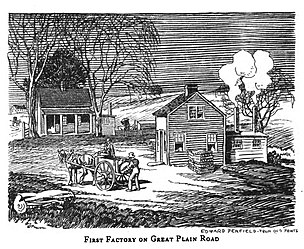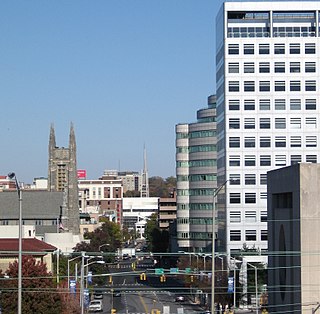
Fairfield County is a county in the southwestern corner of the U.S. state of Connecticut. It is the most populous county in the state and was also its fastest-growing from 2010 to 2020. As of the 2020 census, the county's population was 957,419, representing 26.6% of Connecticut's overall population. The closest to the center of the New York metropolitan area, the county contains four of the state's top 7 largest cities—Bridgeport (1st), Stamford (2nd), Norwalk (6th), and Danbury (7th)—whose combined population of 433,368 is nearly half the county's total population.
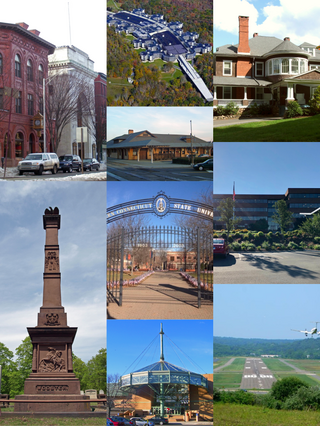
Danbury is a city in Fairfield County, Connecticut, United States, located approximately 50 miles (80 km) northeast of New York City. Danbury's population as of 2022 was 87,642. It is the seventh largest city in Connecticut.
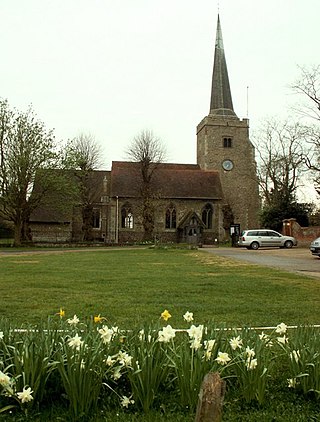
Danbury is a village in the City of Chelmsford district, in the county of Essex, England. It is located 33.5 miles (53.9 km) northeast of Charing Cross, London and has a population of 6,500. It is situated on a hill 367 feet (112 m) above sea level.

Ridgefield is a town in Fairfield County, Connecticut, United States. Situated in the foothills of the Berkshire Mountains, the 300-year-old community had a population of 25,033 at the 2020 census. The town center, which was formerly a borough, is defined by the U.S. Census Bureau as a census-designated place.

One-room schools, or schoolhouses, were commonplace throughout rural portions of various countries, including Prussia, Norway, Sweden, the United States, Canada, Australia, New Zealand, the United Kingdom, Ireland, and Spain. In most rural and small town schools, all of the students met in a single room. There, a single teacher taught academic basics to several grade levels of elementary-age children. While in many areas one-room schools are no longer used, some remain in developing nations and rural or remote areas.
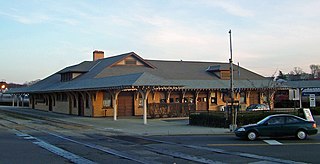
The Danbury Railway Museum is a railway museum housed in the former Union Station on the east end of downtown Danbury, Connecticut, United States. It was established in the mid-1990s following the closure of the station by the Metro-North Railroad in favor of a new station nearby, and primarily focuses on the history of railroading in southern New England and neighboring New York. In addition to the former station building, the museum has a collection of heritage railcars in the neighboring rail yard it shares with Metro-North.

The Danbury Museum and Historical Society is a private museum located in Danbury, Connecticut, the purpose of which is to acquire, preserve, exhibit, and interpret the heritage of the greater Danbury area for education, information, and research. The main campus of the museum is located on 43 Main Street. It is home to five historic buildings: Huntington Hall, the 1785 Rider House, the 1790 John Dodd Hat Shop, the Little Red Schoolhouse, and the Marian Anderson Studio. The Museum also owned and maintained a sixth building: the Charles Ives Birthplace, located on Mountainville Avenue. The Ives birthplace was sold to a private bidder in 2012. Its legal name is the Danbury Scott Fanton Museum and Historical Society, Inc.
Green's Farms is the oldest neighborhood in the town of Westport in Fairfield County, Connecticut, United States. It was listed as a census-designated place prior to the 2020 census.
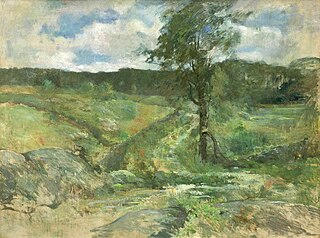
Branchville is a neighborhood of the town of Ridgefield in Fairfield County, Connecticut, United States, and is also the name of a Metro North railroad station. Branchville was listed as a census-designated place (CDP) prior to the 2020 census.

Cannondale is a census-designated place (CDP) within the town of Wilton in Fairfield County, Connecticut. It had a population of 141 at the 2010 census. The neighborhood consists of many old homes on large, almost rural lots now largely wooded. The English first settled the land in the 17th century. At the center of Cannondale is Cannon Crossing, a small shopping village of boutiques and restaurants made up of 19th-century buildings restored by actress June Havoc in the late 1970s on the east side of Cannondale Railroad Station. Both are part of Cannondale Historic District, which encompasses the central part of Cannondale and most of its significant historical buildings.

The Main Street Historic District in Danbury, Connecticut, United States, is the oldest section of that city, at its geographical center. It has long been the city's commercial core and downtown. Its 132 buildings, 97 of which are considered contributing properties, include government buildings, churches, commercial establishments and residences, all in a variety of architectural styles from the late 18th century to the early 20th. It is the only major industrial downtown of its size in Connecticut not to have developed around either port facilities or a water power site.

The John Rider House is located on Main Street in Danbury, Connecticut, United States. It is a wooden frame house dating to the late 18th century.
Banksville is a hamlet in the town of North Castle, Westchester County, New York, United States and an area including Stamford and Greenwich, Connecticut. Estimated to have been founded in the late 1600s, it is an area which had importance for local cottage industries, a boarding school, and local merchants to support its residents in its early days. Banksville was the home of many patriots including veterans who fought in the American Revolution, Civil War and World Wars I and II. Today it remains a vibrant area of neighborhoods that include ancestors from its earliest times.
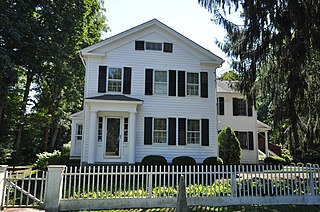
Hattertown is a village in the town of Newtown, Connecticut, that is listed on the National Register of Historic Places as the Hattertown Historic District and includes a smaller local historic district.

Bridgeport is the most populous city and a major port in the U.S. state of Connecticut. With a population of 148,654 in 2020, it is also the fifth-most populous in New England. Located in eastern Fairfield County at the mouth of the Pequonnock River on Long Island Sound, it is 60 miles (97 km) from Manhattan and 40 miles (64 km) from The Bronx. It is bordered by the towns of Trumbull to the north, Fairfield to the west, and Stratford to the east. Bridgeport and other towns in Fairfield County make up the Bridgeport-Stamford-Norwalk-Danbury metropolitan statistical area, the second largest metropolitan area in Connecticut. The Bridgeport-Stamford-Norwalk-Danbury metropolis forms part of the New York metropolitan area.

The former Smith Tavern is located on Bedford Road in the hamlet of Armonk, New York, United States. It is a red frame building dating to the late 18th century, one of the few left in a region that has rapidly suburbanized over the past century. The Smith family, for whom it is named, did not build it but owned it for most of the 19th century.

The Joseph W. Pepin Memorial Building formally known as Alternative Center for Excellence (ACE) and the Alternative Center for Education, is located in the former Locust Avenue School at 26 Locust Avenue in Danbury, Connecticut, United States. It is an alternative high school within Danbury Public Schools, meant for at-risk students.

Lift Off is a public artwork by American artist David Black, located at the CityVista Condominium at the intersection of 5th St NW & K St NW in the Mount Vernon Triangle neighborhood of Washington, D.C., United States. Lift Off was created through DC Commission on the Arts and Humanities.

Mill Plain is an unincorporated area in the City of Danbury, Connecticut, United States. It is located in the westernmost part of the city, bordering the town of Southeast, New York.

Beaverbrook or Beaver Brook, is an unincorporated area in the City of Danbury, Fairfield County, Connecticut.






